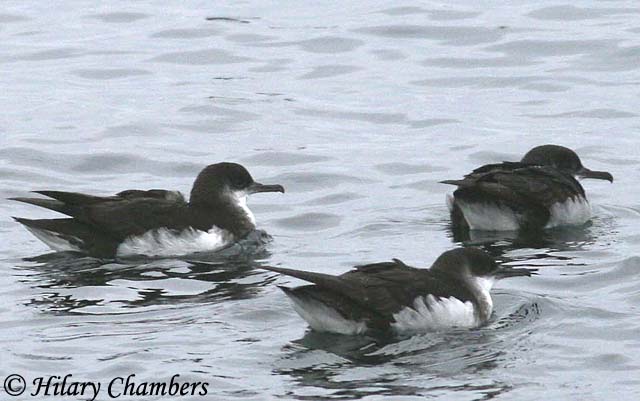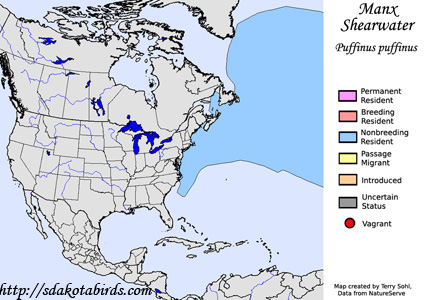| Length: 13 inches | Wingspan: 32 inches | Seasonality: Non-resident in South Dakota |
| ID Keys: Dark upperparts, white underparts and flanks, white undertail coverts, faint crescent "ear" | ||
 The
Manx Shearwater is a small shearwater species that breeds on islands in the
North Atlantic, but is mostly found off the coast of South America during
the North American winter. They were once considered relatively rare
visitors to North America, but in recent decades have expanded their range
and now nest in select island locations off of Newfoundland and New England.
The largest breeding populations are still off the coasts of Great Britain
and in Iceland, however. They are evidently a long-lived species, as one
bird banded in 1957 was recaptured and found to be still breeding in 2002,
with an estimated age of over 50.
The
Manx Shearwater is a small shearwater species that breeds on islands in the
North Atlantic, but is mostly found off the coast of South America during
the North American winter. They were once considered relatively rare
visitors to North America, but in recent decades have expanded their range
and now nest in select island locations off of Newfoundland and New England.
The largest breeding populations are still off the coasts of Great Britain
and in Iceland, however. They are evidently a long-lived species, as one
bird banded in 1957 was recaptured and found to be still breeding in 2002,
with an estimated age of over 50.
Habitat: Nests on islands with suitable areas for digging nesting burrows. Outside of the breeding season, they can be found throughout much of the Atlantic, but typically prefer cooler waters.
Diet: Feeds mostly on small fish, but will also take crustaceans and squid.
Behavior: Forages by swimming below the surface in pursuit of prey, after short dives from flight, or from dives while swimming on the ocean's surface. They will also directly pluck food items near the surface while swimming.
Nesting: Nests in burrows dug in the ground, with both the male and female helping construct the nesting chamber and burrow. The nest itself is a small flat mound of vegetative material with sparse material. The female lays a single egg, and both parents help to incubate it. Upon hatching, both parents help to feed the young.
Song: Usually silent while at sea, but on nesting colonies, they make a series of groaning and cackling calls.
Migration: Breeds in a variety of locations in the North Atlantic, including off the coast of New England and Newfoundland, Iceland, Great Britain, Ireland, the Canary Islands, and the Azores. Outside of the breeding season, disperses widely across the Atlantic, with most birds eventually moving as far south as off the coast of South America and Africa. In North America, they are most common off the East Coast during the summer and early fall months.
Interactive eBird Map: Click here to access an interactive eBird map of Manx Shearwater sightings
Similar Species: In range, most likely to be confused with Audubon's Shearwater.
Conservation Status: Populations have declined in recent decades, but Manx Shearwaters are still widespread and are common in many locations. The IUCN lists the Manx Shearwater as a species of "Least Concern".
Further Information: 1) New Zealand Birds Online - Manx Shearwater
2) Audubon Guide - Manx Shearwater
3) BirdLife International - Manx Shearwater
Photo Information: Photo taken by Hilary Chambers - Photo licensed under Creative Commons Attribution NoDerivs 2.0 Generic license.
| Click below for a higher-resolution map |
 |
| South Dakota Status: Non-resident in South Dakota |
Additional Manx Shearwater Photos (coming soon!!)
